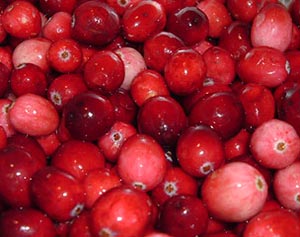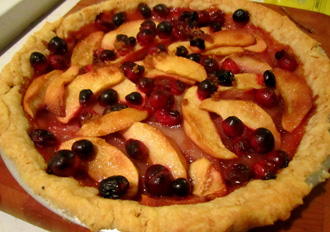Cranberries Nutrition Facts
Cranberries are tart, red berries known for their unique taste and potential medicinal properties. Thriving in their wild and natural habitat, these tiny berries are plentiful in phytonutrients (naturally derived plant compounds), especially proanthocyanidin antioxidants, crucial for holistic wellness.
The cranberry plant is either an evergreen, dwarf, creeping shrub, or a low-lying trailing vine, classified under the family Ericaceae, genus Vaccinium, and subgenus Oxycoccos. Its scientific name is Vaccinium macrocarpon.
 |
| Cranberries. Photo: bcmom |
In its natural habitat, the cranberry plant thrives vigorously in acidic sandy bogs, spanning the temperate and cooler regions of Europe, Northern states in the United States, and Canada. This plant, whether a dwarf, creeping shrub, or vine, typically reaches heights of 10 to 20 cm, characterized by slender, wiry, not-so-thick, woody stems adorned with small, evergreen leaves.
The cranberry season extends from October to December, offering small, round, red berries. Each berry contains four tiny seeds nestled within capsules, contributing to its characteristic acidic taste, with a pH ranging from 2.3 to 2.5.
7 Amazing Health Benefits of Cranberries
Cranberries, with their delicious tartness, boast significantly high levels of phenolic flavonoid phytochemicals known as proanthocyanidins (PACs). Scientific research indicates that consuming these berries may offer potential health advantages against cancer, aging, neurological diseases, inflammation, diabetes, and bacterial infections.
Antioxidant compounds found in cranberries, including oligomeric proanthocyanidins (OPCs), anthocyanidin flavonoids, cyanidin, peonidin, and quercetin, could provide protection against cardiovascular disease by preventing the formation of cholesterol plaque in the heart and blood vessels. Additionally, these compounds assist in lowering LDL cholesterol levels while increasing HDL-good cholesterol levels.
Studies suggest that drinking cranberry juice may defend against gram-negative bacterial infections such as E.coli in the urinary system by inhibiting bacterial attachment to the bladder and urethral mucosal wall.
Consuming cranberries can acidify urine, along with inhibiting bacterial adhesion actions, which can help prevent the formation of alkaline (calcium-ammonium-phosphate) stones in the urinary tract, particularly against Proteus bacterial infections.
Moreover, cranberries prevent plaque formation on tooth enamel by disrupting the ability of the gram-negative bacterium Streptococcus mutans to adhere to the tooth surface, thereby aiding in cavity prevention.
Furthermore, cranberries serve as an excellent source of various vitamins such as vitamin C, vitamin A, folate, and phenolics like ß-carotene, lutein, zeaxanthin, as well as minerals like potassium and manganese.
The Oxygen Radical Absorbance Capacity (ORAC) of cranberries, measuring antioxidant strength, is remarkable, with an ORAC score of 9584 µmol TE units per 100 g, one of the highest among edible berries.
| Principle | Nutrient Value | Percent of RDA |
|---|---|---|
| Energy | 46 Kcal | 2.3% |
| Carbohydrates | 12.2 g | 9% |
| Protein | 0.4 g | 1% |
| Total Fat | 0.13 g | <1% |
| Cholesterol | 0 mg | 0% |
| Dietary Fiber | 4.6 g | 12% |
| Vitamins | ||
| Folates | 1 µg | <1% |
| Niacin | 0.101 mg | 1% |
| Pantothenic acid | 0.295 mg | 6% |
| Pyridoxine | 0.057 mg | 4% |
| Riboflavin | 0.020 mg | 2% |
| Thiamin | 0.012 mg | 1% |
| Vitamin A | 60 IU | 2% |
| Vitamin C | 13.3 mg | 22% |
| Vitamin E | 1.20 mg | 8% |
| Vitamin K | 5.1 µg | 4% |
| Electrolytes | ||
| Sodium | 2 mg | 0% |
| Potassium | 85 mg | 2% |
| Minerals | ||
| Calcium | 8 mg | 1% |
| Copper | 0.061 mg | 7% |
| Iron | 0.25 mg | 3% |
| Magnesium | 6 mg | 1.5% |
| Manganese | 0.360 mg | 16% |
| Phosphorus | 13 mg | 2% |
| Selenium | 0.1 µg | 0% |
| Zinc | 0.10 mg | 1% |
| Phyto-nutrients | ||
| Carotene-ß | 36 µg | -- |
| Crypto-xanthin-ß | 0 µg | -- |
| Lutein-zeaxanthin | 91 µg | -- |
Choosing and Storing Cranberries
From October to December, fresh cranberries are typically available. When selecting them in stores, opt for berries that are bright red, plump, and have intact skin, avoiding any with wrinkles, cuts, or cracks. The antioxidant pigments are most concentrated in berries with deep red skin.
While fresh and dried cranberries are rich in antioxidants, cranberry drinks and cocktails with added sugars may lack them.
Remove any wet or mottled berries to prevent mold from spreading to the rest.
Fresh berries can be refrigerated for several days. Before storing, discard any discolored, soft, shriveled, or sticky fruits. They have a short shelf life at room temperature.
Preparation and serving method
 |
| cranberry-pie. Photo: Amy Ross |
In their natural environment, cranberries picked by hand can be eaten directly. When purchasing from stores, select bright, uniform berries. Wash them in cold water just before using to maintain their texture.
Here are some serving tips:
Enjoy raw, fresh, or dried cranberries as snacks.
Add tart berries to both vegetable and fruit salads.
Incorporate berries into sorbets and fruit cocktails.
Use them in muffins, pie fillings, breads, and ice creams.
Utilize cranberries in sauces, jams, and jellies, common in the food industry.
Employ cranberry sauce in traditional poultry dishes.
Safety profile
Cranberries naturally contain oxalic acid, a substance also found in certain fruits and vegetables such as spinach, and kale. Oxalic acid can crystallize into oxalate stones in the urinary tract, particularly concerning for individuals with a history of oxalate urinary tract stones. It's recommended for such individuals to moderate their intake of cranberries and maintain adequate hydration to support normal urine output.
Effects on Mineral Absorption
Interaction with Medications
The cranberry institute- About cranberries.(Link opens in new window)
Furthermore, oxalic acid can interfere with the absorption of essential minerals like calcium and magnesium, potentially leading to deficiencies in these nutrients.
Research indicates that cranberry juice can potentiate the anticoagulant effect of medications like warfarin. Some patients undergoing warfarin therapy have experienced excessive bleeding in various organ systems after consuming cranberry juice. Patients on warfarin should be advised to avoid cranberry juice to prevent potential complications.
(Medical Disclaimer: The information and reference guides on this website are intended solely for the general information of the reader. It is not to be used to diagnose health problems or for treatment purposes. It is not a substitute for medical care provided by a licensed and qualified health professional. Please consult your health care professional for any advice on medications.)
Also read ≻≻-
≻≻-Blueberries Nutrition facts.
≻≻-Chokeberries Nutrition facts.
≻≻-Currants Nutrition facts.
≻≻-Blackberries Nutrition facts.
≻≻-Back to Fruits from Cranberries. Visit here for an impressive list of all variety of fruits with complete illustrations of their nutrition facts and health benefits.
≻≻-Back to Home page.
Further resources: